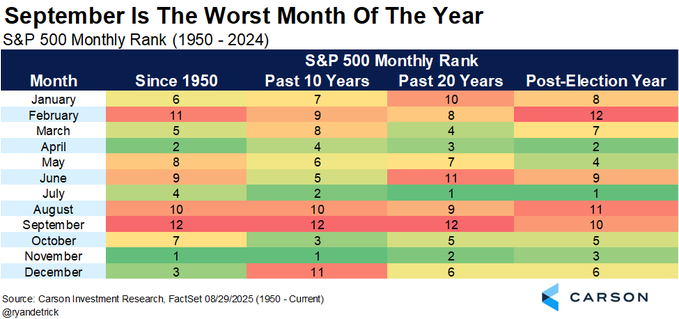September seasonality looms: historically the weakest month, with structural headwinds adding risk.
AI
Table of Contents
Trip.com jumped 13.55% this week after its board authorized a new $5 billion share repurchase program covering both ordinary shares and ADSs. The move underscores confidence in the company’s long-term outlook and capital position, marking one of the largest buyback programs among Chinese travel platforms.
September has long carried a reputation as the market’s weakest month. Since 1927, the S&P 500 has posted negative returns 56% of the time, with an average decline of –1.2%. Unlike October, which often sparks rebounds, September’s drag reflects a mix of structural headwinds: quarter-end tax payments and Treasury issuance draining liquidity, mutual fund and pension rebalancing, and a tendency for investors to reduce risk ahead of earnings season.
This year those seasonal pressures collide with unusually narrow market breadth and record hedge fund crowding in megacaps. Positioning is stretched, while short interest in volatility is near extremes—leaving the tape vulnerable to a sharp reversal if a catalyst emerges.
Historically, defensive groups like healthcare ($XLV), consumer staples ($XLP), and utilities ($XLU) have held up best in September, while small caps ($IWM) and select cyclicals ($XLI) sometimes outperform once the Fed signals easing. For tactical traders, volatility hedges ($VIX)—such as VIX call spreads or index put spreads—tend to offer cheap insurance when the VIX sits near cycle lows.
The takeaway: September is rarely a month to chase highs. A defensive tilt, paired with selective exposure to sectors that benefit from falling rates, has historically outperformed. October often resets the stage—but first comes a seasonal test of discipline.

Cracker Barrel (CBRL) became a political flashpoint this week, with shares jumping nearly 10% after President Trump weighed in Tuesday morning, urging the company to restore its classic “old timer” logo after replacing it to be more "inclusive." Management quickly complied, scrapping the modern redesign that had sparked backlash from conservatives. The reversal underscored how fast cultural controversies—and Trump’s direct involvement—can move consumer-facing stocks.

American Eagle (AEO) also saw a boost, with shares up as much as 6.1% midweek following its pivot from the Sydney Sweeney campaign backlash to a splashy new collaboration with NFL star Travis Kelce. The AE x Tru Kolors line dropped just after Kelce’s engagement to Taylor Swift, driving visibility and investor interest ahead of next week’s earnings.
The takeaway: political endorsements and cultural flashpoints are now market catalysts, sparking rallies in retail names long before fundamentals catch up.
Join LevelFields now to be the first to know about events that affect stock prices and uncover unique investment opportunities. Choose from events, view price reactions, and set event alerts with our AI-powered platform. Don't miss out on daily opportunities from 6,300 companies monitored 24/7. Act on facts, not opinions, and let LevelFields help you become a better trader.

AI scans for events proven to impact stock prices, so you don't have to.
LEARN MORE